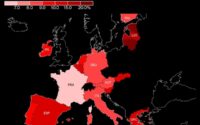“Central Banks Need To Be Targeting MWh And Tonnes Of Production Soviet Style, Not Inflation”
By Michael Every of Rabobank
Steep Learning Curves
Yesterday saw a marked shift in bond yields and some steepening curves. US 2-year Treasury yields were +12bp to 3.50% and 10-years +16bp to 3.35%. The primary driver was a stronger than expected US ISM survey at 56.9 vs. 55.3 consensus, which outranked the dismal services PMI released shortly before, where the reading was only 43.7 vs. 44.2 expected. Will the real service sector please stand up?
UK 2-year Gilt yields were up little changed at the close. 10-years were a bigger rollercoaster than Alton Towers before closing +8bps. That’s what happens when the government launches an energy subsidy which could cost 5% of GDP and last until the current geopolitical crisis is resolved.
German 2-year Bund yields plunged from 1.14% to 0.95% before bouncing to close -4bps at 1.10%. 10-years were +2bps, -11bps, +16bps, -5bps, and closed +6bps at 1.63%. That was as Europe also gets ready to roll out massive open-ended energy subsidies, with market talk of up to €2 trillion as the bill – again presuming we know when the end date is, which we don’t. And don’t forget a massive new defence-spending round must be on the table at the same time. And to add to the fun, there are also reports that global energy traders need (Western) state bailouts of up to $1.5 trillion to cover margin calls.
Japan joined in today with a new ¥50,000 hand-out for low-income families. Those paying attention will also note a wide range of emerging markets are doing similar things. In short, hardly anyone is prepared to pay the real global energy price and lower demand in that painful manner. That means wholesale prices will just rise further – but that’s also a steep (learning) curve for some, it seems.
So to central banks. The Fed is going to keep hiking against this backdrop as the market starts looking at the 4% Fed Funds level again. The RBA hiked 50bps yesterday to take its OCR to 2.35%, through gritted teeth in saying medium-term inflation expectations are “well anchored”, and the market is again focused on 4%. The RBNZ thinks the same 4%. The BOC lifted rates to 3.25% today, with 4% again seen as a likely finishing point. But what will the BOE do given the new energy subsidy? What will the ECB do? Even before the ink is dry on EU fiscal largesse we got hints ECB President Lagarde might be happy with 50bps and a promise to “do whatever it takes” if inflation persists(!), while the risk is that even 75bps might be presented as a one-off Herculean effort deserving market praise.
In short, my meme that ‘DM=EM’ is looking bang on the money as Western governments try to repeat what they did during 2008’s and 2012’s liquidity crises with a global energy crisis. Politically, you can’t blame them; but you also can’t ‘print electricity’. As noted this week, we will still need rationing, if not by price. That implies central-planning from governments that only have one plan – ‘make this all go away’.
One therefore may have to theoretically flag the tail risk of a steepening tone to some yield curves, as seen yesterday, due to artificially declining inflation at the short end — especially if central banks buy what governments are selling with both hands, as consumers will with cheap energy — and as the market looks at the longer end of the yield curve, and banana-republic populist fiscal management becoming embedded, and thinks, “Really?”
Of course, in reality central banks can avoid this by repressing bond yields: we have ample evidence of that.
But what they cannot then do is also prop up their currency: and we have ample evidence of that too. Look at JPY, trading at 144.9 this morning, with 150 still a whisper number. If one applies the JPY trend across to EUR and GBP, one gets numbers like EUR/USD at 0.80 and GBP/USD at 0.90, both of which are inflationary on the import side. Neither are forecasts! But both look at how much further JPY has fallen on the BOJ’s “print it and they will come” policy stance. As such, expect a soaring Dollar and Fed swap lines to be a very big and very geopolitical thing very shortly – which is another theme flagged here for years.
Meanwhile, it is widely accepted that rate hikes can’t address supply shocks, and tightening now is a deliberate policy error by central banks. The same view rightly holds that ultra-low rates couldn’t raise inflation before Covid, thus the persistent flattening yield-curve trend that was seen for years, and again until recently. Yet combine the two views and we are saying interest rates cannot do anything about structural inflation most of the time: so why are we paying attention to monetary policy at all?
Indeed, looking back to really long-run inflation charts shows we constantly move through (geo)political structures that are either more or less inflationary: today, central banks are just along for the ride too.
The real solution to this inflation crisis obviously lies on the supply side, in terms of energy and other key goods. Yet that really takes us a step away from inflation-targeting and back towards an echo of how macro-stability was previously achieved. Under historical gold standards inflation was highly volatile, soaring and crashing year after year, because it was not what mattered: what was instead targeted was the stock and flow of bullion in and out of the country, like FX reserves until recently. This flow was best balanced by making sure one exported and imported appropriately, and focused on more exports and less imports, i.e., mercantilism. That was best achieved on the supply side!
The point is that one can start to construct a new mental framework where central banks actually need to be targeting MWh and tonnes of production, Soviet style, as the key macro-stability anchor: get that right, and get moderate inflation. Target just inflation, which you cannot control, and which governments are only pretending they can, and you won’t end up with macro-stability or low inflation.
Sadly, that might be a steeper learning curve for some.
[ad_2]
Source link


